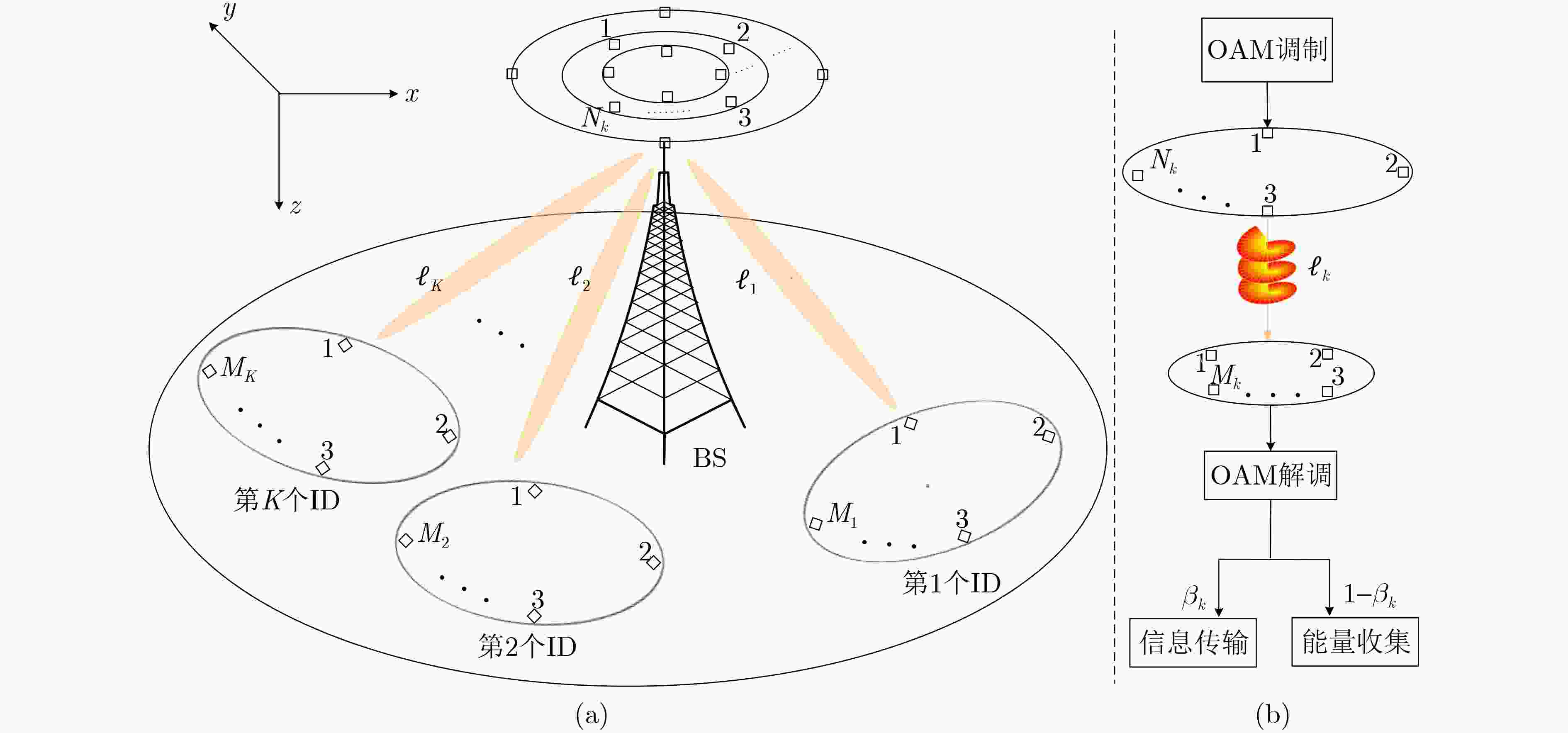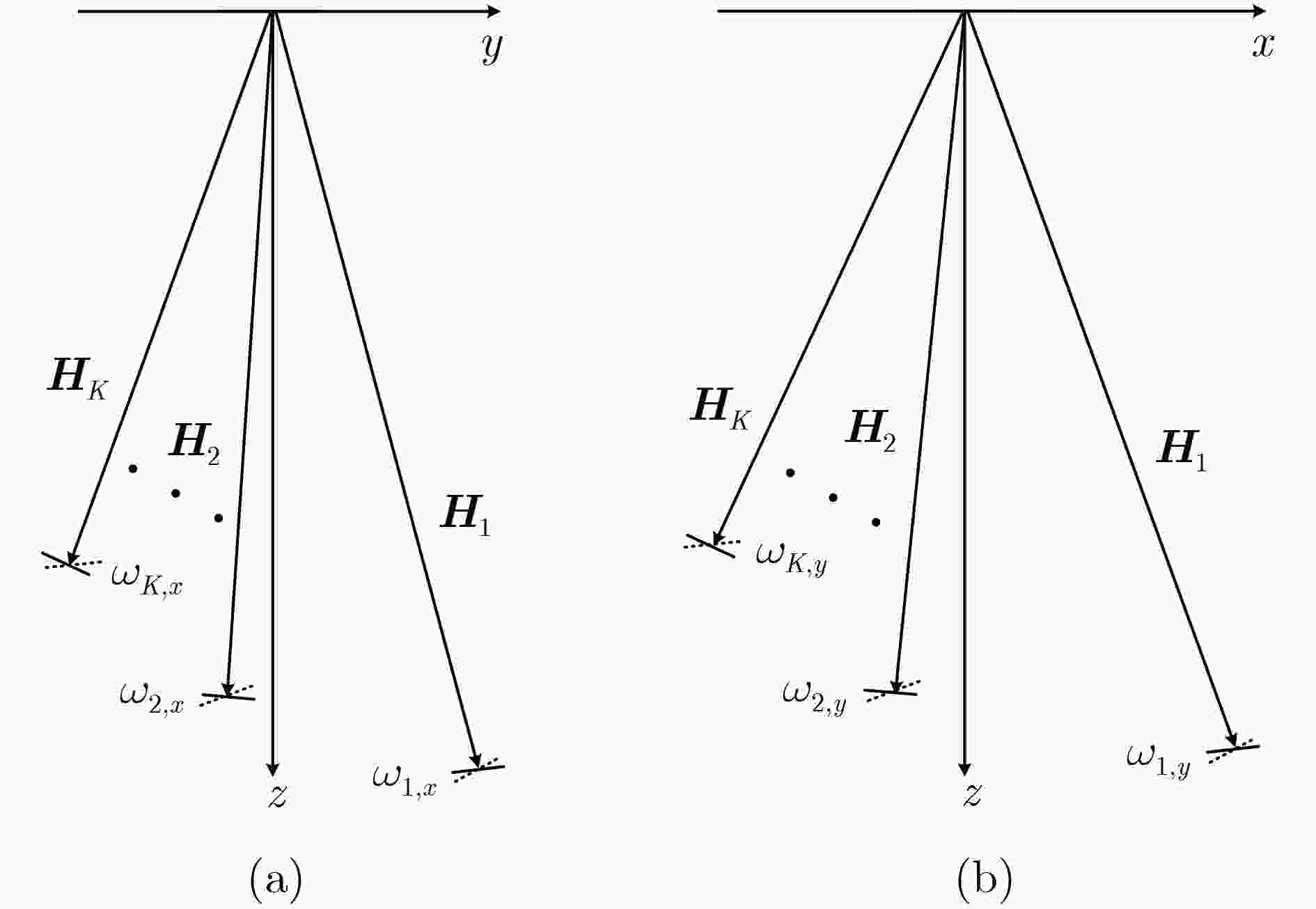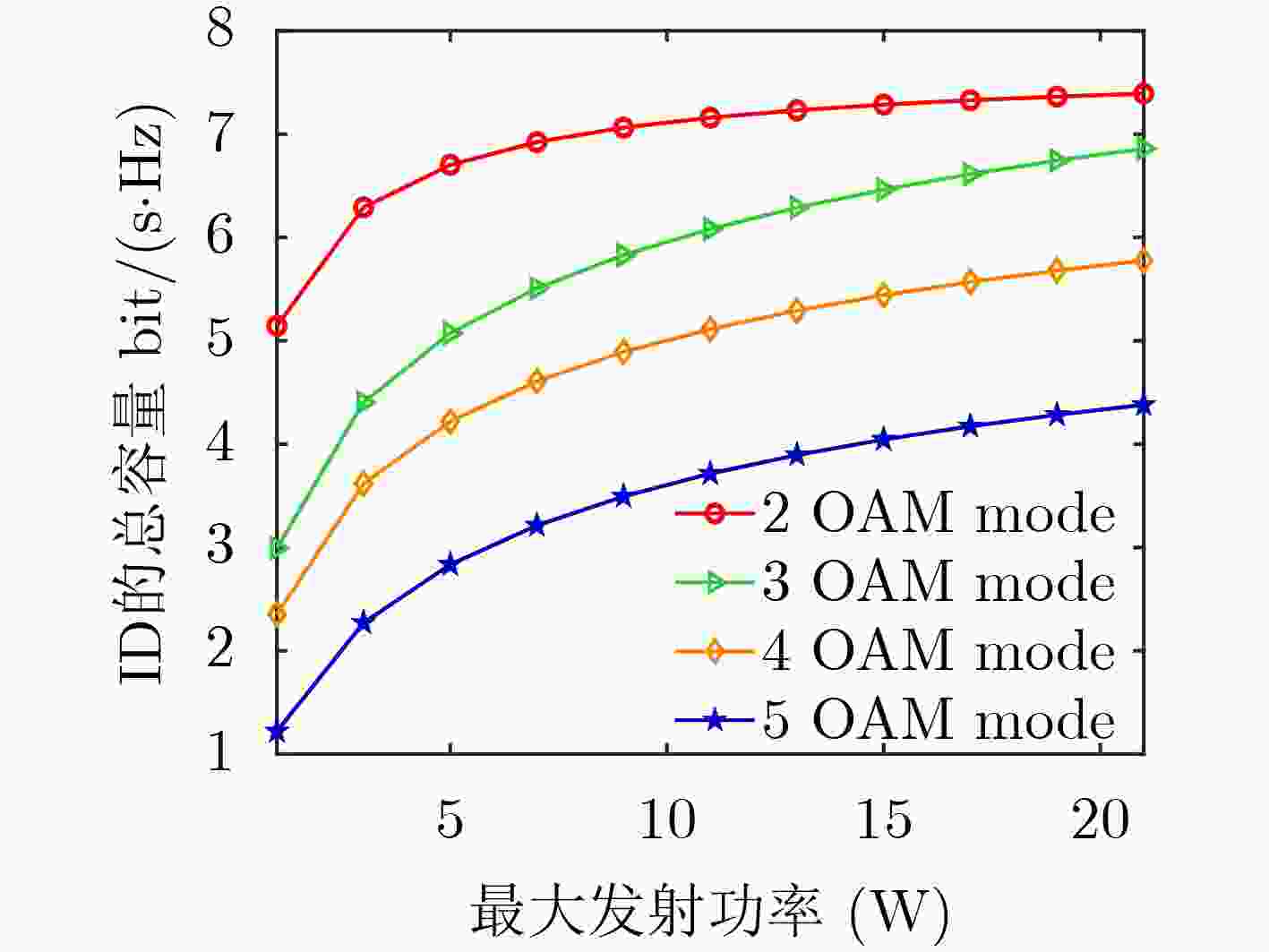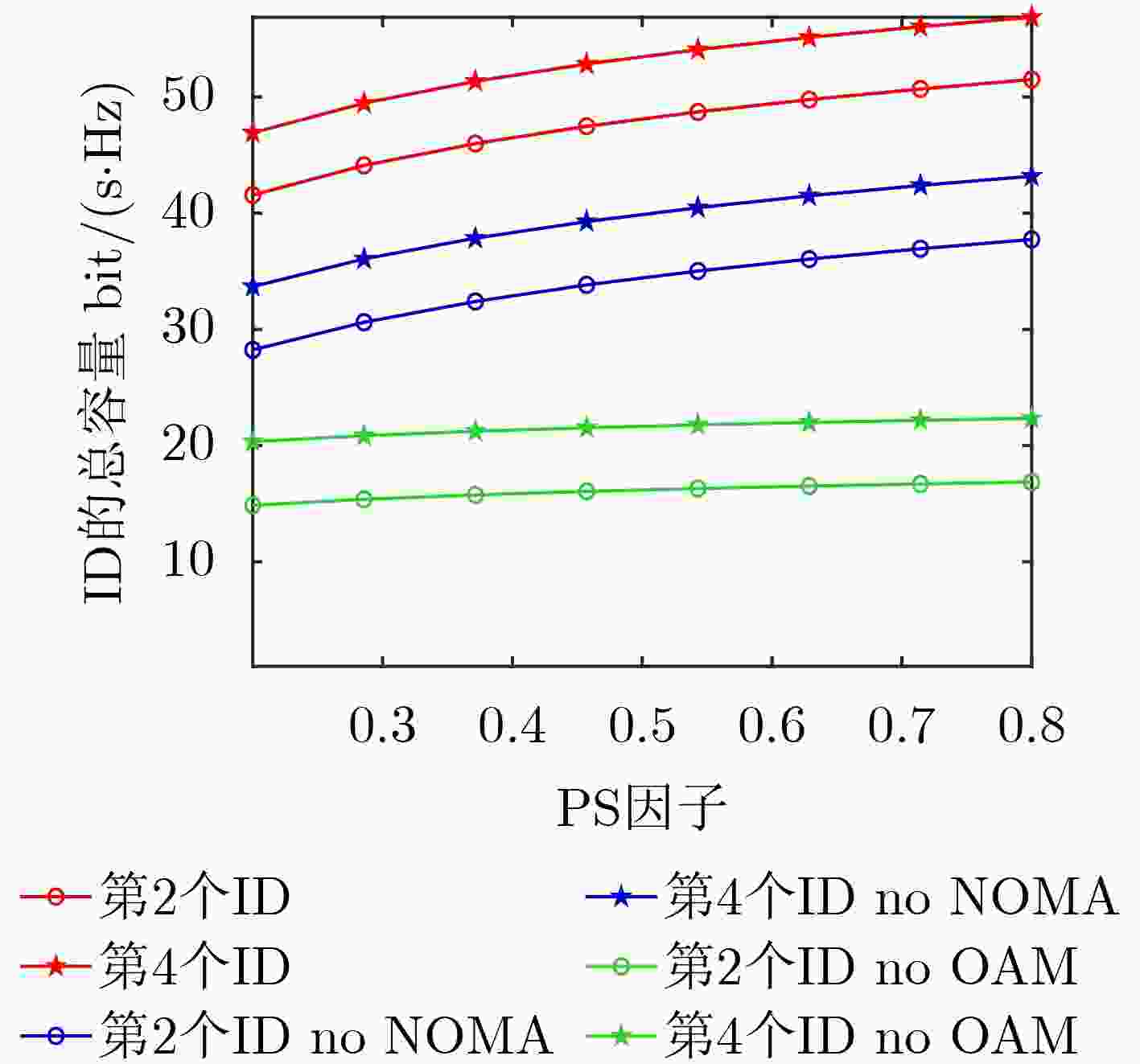Design and Optimization for Orbital Angular Momentum–based wireless-powered Noma Communication System
-
摘要: 视距信道是实现高效无线供能NOMA通信的必要条件,然而其强相关性将严重限制空间自由度,导致传统空间复用技术难以获得容量增益。利用新维度的轨道角动量(Orbital Angular Momentum, OAM),该文设计了基于OAM的无线供能NOMA通信系统,其可以通过模态复用独立传输多路信息从而在视距信道下显著提高通信容量。通过转化收集能量为信息上传的可实现容量,该文在通信容量和收集能量的阈值约束下构建了系统的总容量最大化问题。然后,将系统总容量最大化问题分解为两个子问题,推导了最优功率分割因子的闭式表达式,并利用次梯度方法获得了最优的功率分配。仿真结果表明,与传统无线通信系统相比,所提出的基于OAM的无线供能NOMA通信系统能够有效提高容量性能。Abstract:
Objective The Internet of Things (IoT) requires not only interconnection among devices but also seamless connectivity among users, information, and things. Ensuring stable operation and extending the lifespan of IoT Devices (IDs) through continuous power supply have become urgent challenges in IoT-driven Sixth-Generation (6G) communications. Radio Frequency (RF) signals can simultaneously transmit information and energy, forming the basis for Simultaneous Wireless Information and Power Transfer (SWIPT). Non-Orthogonal Multiple Access (NOMA), a key technology in Fifth-Generation (5G) communications, enables multiple users to share the same time and frequency resources. Efficient wireless-powered NOMA communication requires a Line-of-Sight (LoS) channel. However, the strong correlation in LoS channels severely limits the degree of freedom, making it difficult for conventional spatial multiplexing to achieve capacity gains. To address this limitation, this study designs an Orbital Angular Momentum (OAM)-based wireless-powered NOMA communication system. By exploiting OAM mode multiplexing, multiple data streams can be transmitted independently through orthogonal OAM modes, thereby significantly enhancing communication capacity in LoS channels. Methods The OAM-based wireless-powered NOMA communication system is designed to enable simultaneous energy transfer and multi-channel information transmission for IDs under LoS conditions. Under the constraints of the communication capacity threshold and the harvested energy threshold, this study formulates a sum-capacity maximization problem by converting harvested energy into the achievable uplink information capacity. The optimization problem is decomposed into two subproblems. A closed-form expression for the optimal Power-Splitting (PS) factor is derived, and the optimal power allocation is obtained using the subgradient method. The transmitting Uniform Circular Array (UCA) employs the Movable Antenna (MA) technique to adjust both position and array angle. To maintain system performance under typical parallel misalignment conditions, a beam-steering method is investigated. Results and Discussions Simulation results demonstrate that the proposed OAM-based wireless-powered NOMA communication system effectively enhances capacity performance compared with conventional wireless communication systems. As the OAM mode increases, the sum capacity of the ID decreases. This occurs because higher OAM modes exhibit stronger hollow divergence characteristics, resulting in greater energy attenuation of the received OAM signals ( Fig. 3 ). The sum capacity of the ID increases with the PS factor (Fig. 4 ). However, as the harvested energy threshold increases, the system’s sum capacity decreases (Fig. 5 ). When the communication capacity threshold increases, the sum capacity first rises and then gradually declines (Fig. 6 ). In power allocation optimization, allocating more power to the ID with the best channel condition further improves the total system capacity.Conclusions To enhance communication capacity under LoS conditions, this study designs an OAM-based wireless-powered NOMA communication system that employs mode multiplexing to achieve independent multi-channel information transmission. On this basis, a sum-capacity maximization problem is formulated under communication capacity and harvested energy threshold constraints by transforming harvested energy into achievable uplink information capacity. The optimization problem is decomposed into two subproblems. A closed-form expression for the optimal PS factor is derived, and the optimal power allocation is obtained using the subgradient method. In future work, the MA technique will be integrated into the proposed OAM-based wireless-powered NOMA system to further optimize sum-capacity performance based on the three-dimensional spatial configuration and adjustable array angle. -
Key words:
- Orbital Angular Momentum (OAM) /
- Wireless-powered /
- NOMA /
- Capacity
-
表 1 符号表示
符号 表示 ${\ell _k}$, $ {{\boldsymbol{H}}_k} $, ${\beta _k}$ OAM模态,发射UCA和接收UCA之间信道矩阵,
PS因子${n_k}$, ${m_k}$ 发射天线单元,接收天线单元 $ {D_k} $, $ {d_k} $ 发射UCA的半径,接收UCA的半径 $ {\omega _{k, x}} $, $ {\omega _{k, y}} $ 接收UCA绕x轴的旋转角度,接收UCA绕y轴的
旋转角度$ {{\boldsymbol{\varTheta}} _x}(\omega ) $, 围绕x轴的旋转矩阵,围绕y轴的旋转矩阵 $ {{\boldsymbol{\varTheta}} _y}(\omega ) $ 发射UCA的初始方位角,接收UCA的初始方位角 ${\theta _k}$, ${\phi _k}$ 信息传输容量,所有ID信息传输容量的总和 $ {R_k} $, $ R $ 收集到的能量,所有ID的总收集能量 $ {E_k} $, E 功率分配矩阵,同心UCA的发射信号向量,
高斯白噪声${\boldsymbol{P}}$, ${\boldsymbol{s}}$, $ {{\boldsymbol{n}}} $ 载波波长,由于天线方向图、相位旋转等因素引起的
增益衰减,$\lambda $, $ \tau $, ${{\boldsymbol{W}}_{{\text{OAM}}}}$ OAM调制矩阵 -
[1] VAEZI M, AZARI A, KHOSRAVIRAD S R, et al. Cellular, wide-area, and non-terrestrial IoT: A survey on 5g advances and the road toward 6G[J]. IEEE Communications Surveys & Tutorials, 2022, 24(2): 1117–1174. doi: 10.1109/COMST.2022.3151028. [2] DASH S P, JOSHI S, SATAPATHY S C, et al. A cybertwin-based 6g cooperative IoE communication network: Secrecy outage analysis[J]. IEEE Transactions on Industrial Informatics, 2022, 18(7): 4922–4932. doi: 10.1109/TII.2021.3140125. [3] KISHK M A and DHILLON H S. Coexistence of RF-powered IoT and a primary wireless network with secrecy guard zones[J]. IEEE Transactions on Wireless Communications, 2018, 17(3): 1460–1473. doi: 10.1109/TWC.2017.2778703. [4] 马克明, 陈亚军, 胡鑫, 等. 面向物联网无线携能通信系统的机会安全传输方案[J]. 通信学报, 2019, 40(2): 70–81. doi: 10.11959/j.issn.1000?436x.2019036.MA Keming, CHEN Yajun, HU Xin, et al. Opportunistic secure transmission scheme for simultaneous wireless information and power transfer[J]. Journal on Communications, 2019, 40(2): 70–81. doi: 10.11959/j.issn.1000?436x.2019036. [5] 徐勇军, 刘子腱, 李国权, 等. 基于NOMA的无线携能D2D通信鲁棒能效优化算法[J]. 电子与信息学报, 2021, 43(5): 1289–1297. doi: 10.11999/JEIT200175.XU Yongjun, LIU Zijian, LI Guoquan, et al. Robust energy efficiency optimization algorithm for NOMA-based D2D communication with simultaneous wireless information and power transfer[J]. Journal of Electronics & Information Technology, 2021, 43(5): 1289–1297. doi: 10.11999/JEIT200175. [6] PERERA T D P, JAYAKODY D N K, SHARMA S K, et al. Simultaneous wireless information and power transfer (SWIPT): Recent advances and future challenges[J]. IEEE Communications Surveys & Tutorials, 2018, 20(1): 264–302. doi: 10.1109/COMST.2017.2783901. [7] XU Kui, SHEN Zhexian, WANG Yurong, et al. Hybrid time-switching and power splitting SWIPT for full-duplex massive MIMO systems: A beam-domain approach[J]. IEEE Transactions on Vehicular Technology, 2018, 67(8): 7257–7274. doi: 10.1109/TVT.2018.2831790. [8] CHEN Jie, ZHANG Lin, LIANG Yingchang, et al. Resource allocation for wireless-powered IoT networks with short packet communication[J]. IEEE Transactions on Wireless Communications, 2019, 18(2): 1447–1461. doi: 10.1109/TWC.2019.2893335. [9] YU Yu, TANG Jie, HUANG Jiayi, et al. Multi-objective optimization for UAV-assisted wireless powered IoT networks based on extended DDPG algorithm[J]. IEEE Transactions on Communications, 2021, 69(9): 6361–6374. doi: 10.1109/TCOMM.2021.3089476. [10] ZHU Zhengyu, LI Zheng, CHU Zheng, et al. Resource allocation for intelligent reflecting surface assisted wireless powered IoT systems with power splitting[J]. IEEE Transactions on Wireless Communications, 2022, 21(5): 2987–2998. doi: 10.1109/TWC.2021.3117346. [11] CHU Zheng, XIAO Pei, MI De, et al. Multi-IRS assisted multi-cluster wireless powered IoT networks[J]. IEEE Transactions on Wireless Communications, 2023, 22(7): 4712–4728. doi: 10.1109/TWC.2022.3228017. [12] ZHAI Liangsen, ZOU Yulong, and ZHU Jia. Stackelberg game-based multiple access design for intelligent reflecting surface assisted wireless powered IoT networks[J]. IEEE Transactions on Wireless Communications, 2023, 22(10): 6883–6897. doi: 10.1109/TWC.2023.3246561. [13] KUMAR D, KUMAR SINGH C, ALCARAZ LÓPEZ O L, et al. Performance analysis of passive/active RIS aided wireless-powered IoT network with nonlinear energy harvesting[J]. IEEE Transactions on Wireless Communications, 2025, 24(2): 1132–1145. doi: 10.1109/TWC.2024.3505296. [14] ISLAM S M R, AVAZOV N, DOBRE O A, et al. Power-domain non-orthogonal multiple access (NOMA) in 5G Systems: Potentials and Challenges[J]. IEEE Communications Surveys & Tutorials, 2017, 19(2): 721–742. doi: 10.1109/COMST.2016.2621116. [15] 李兴旺, 王新莹, 田心记, 等. 基于非理想条件可重构智能超表面辅助无线携能通信-非正交多址接入系统通感性能研究[J]. 电子与信息学报, 2024, 46(6): 2434–2442. doi: 10.11999/JEIT231395.LI Xingwang, WANG Xinying, TIAN Xinji, et al. Communication and sensing performance analysis of RIS-assisted SWIPT-NOMA system under non-ideal conditions[J]. Journal of Electronics & Information Technology, 2024, 46(6): 2434–2442. doi: 10.11999/JEIT231395. [16] KHAVARI-MOGHADDAM S, FARAHMAND S, RAZAVIZADEH S M, et al. Optimum solutions for weighted sum-rate of NOMA and TDMA in wireless-powered IoT networks[J]. IEEE Internet of Things Journal, 2024, 11(2): 3302–3315. doi: 10.1109/JIOT.2023.3297719. [17] WANG Jie, KANG Xin, SUN Sumei, et al. Throughput maximization for peer-assisted wireless powered IoT NOMA networks[J]. IEEE Transactions on Wireless Communications, 2020, 19(8): 5278–5291. doi: 10.1109/TWC.2020.2991400. [18] LI Xingwang, WANG Qunshu, LIU Meng, et al. Cooperative wireless-powered NOMA relaying for B5G IoT networks with hardware impairments and channel estimation errors[J]. IEEE Internet of Things Journal, 2021, 8(7): 5453–5467. doi: 10.1109/JIOT.2020.3029754. [19] VU T H and KIM S. Performance evaluation of power-beacon-assisted wireless-powered NOMA IoT-based systems[J]. IEEE Internet of Things Journal, 2021, 14(15): 11655–11665. doi: 10.1109/JIOT.2021.3058680. [20] VU T H, NGUYEN T V, and KIM S. Wireless powered cognitive NOMA-based IoT relay networks: Performance analysis and deep learning evaluation[J]. IEEE Internet of Things Journal, 2022, 9(5): 3913–3929. doi: 10.1109/JIOT.2021.3100616. [21] NGUYEN M T, VU T H and KIM S. Performance analysis of wireless powered cooperative NOMA-based CDRT IoT networks[J]. IEEE Systems Journal, 2022, 16(4): 6501–6512. doi: 10.1109/JSYST.2022.3144023. [22] LYU Runyu, CHENG Wenchi, WANG Muyao, et al. A modified 3D-GBSM for OAM wireless communication at 5.8 and 28-GHz[J]. IEEE Transactions on Wireless Communications, 2025, 24(10): 8799–8813. doi: 10.1109/TWC.2025.3569098. [23] CHEN Rui, ZHOU Hong, MORETTI M, et al. Orbital angular momentum waves: Generation, detection, and emerging applications[J]. IEEE Communications Surveys & Tutorials, 2020, 22(2): 840–868. doi: 10.1109/COMST.2019.2952453. [24] YU Wei, ZHOU Bin, XU Fangying, et al. The impact of asymmetric antenna element's radiation pattern and its solution analysis for UCA-based OAM communications[J]. IEEE Transactions on Vehicular Technology, 2025, 74(3): 4554–4568. doi: 10.1109/TVT.2024.3498005. [25] CHEN Ruirui, CHENG Wenchi, XU Keyue, et al. NOMA-enhanced IRS for wireless-powered OAM communications via joint power allocation and passive beamforming[J]. IEEE Transactions on Communications, 2025, 73(7): 5420–5432. doi: 10.1109/TCOMM.2024.3522045. [26] MA Xiaoyan, ZHAO Yufei, ZHANG Haixia, et al. Joint precoder and reflector design for RIS-assisted multi-user OAM communication systems[J]. IEEE Transactions on Wireless Communications, 2025. doi: 10.1109/TWC.2025.3585531. (查阅网上资料,未找到卷期页码信息,请确认). [27] SASAKI H, YAGI Y, FUKUMOTO H, et al. OAM-MIMO multiplexing transmission system for high-capacity wireless communications on millimeter-wave band[J]. IEEE Transactions on Wireless Communications, 2024, 23(5): 3990–4003. doi: 10.1109/TWC.2023.3313735. [28] CHEN Yuqi, XIONG Xiaowen, ZHENG Shilie, et al. OAM spatial field digital modulation system for physical-level secure communication[J]. IEEE Transactions on Wireless Communications, 2024, 23(12): 18472–18486. doi: 10.1109/TWC.2024.3468349. [29] GAO Weijun, YANG Zhirong, and HAN Chong. Channel modeling and evaluation on terahertz orbital angular momentum (OAM)-based intersatellite communications[J]. IEEE Transactions on Antennas and Propagation, 2025, 73(7): 4840–4852. doi: 10.1109/TAP.2025.3551609. [30] CHEN Rui, CHEN Min, XIAO Xiao, et al. Multi-user orbital angular momentum based terahertz communications[J]. IEEE Transactions on Wireless Communications, 2023, 22(9): 6283–6297. doi: 10.1109/TWC.2023.3241287. [31] KHAN M L W, WOO J, YI Xiang, et al. A 0.31-THz orbital-angular-momentum (OAM) wave transceiver in CMOS with bits-to-OAM mode mapping[J]. IEEE Journal of Solid-State Circuits, 2022, 57(5): 1344–1357. doi: 10.1109/JSSC.2022.3141366. [32] ZHU Lipeng, MA Wenyan, and ZHANG Rui. Movable antennas for wireless communication: Opportunities and challenges[J]. IEEE Communications Magazine, 2024, 62(6): 114–120. doi: 10.1109/MCOM.001.2300212. -






 下载:
下载:







 下载:
下载:
